150 year old ice-cream cake dessert
I am fascinated by old cookbooks, they are a window back in time. Preparing a recipe with only the tools they had at hand makes you appreciate not only the appliances we take for granted but also just how much effort they would go to in order to impress. The cookbook we are looking at today, THE ROYAL BOOK OF PASTRY AND CONFECTIONERY is by JULES GOUFFÉ, 1874.

The recipe details are:
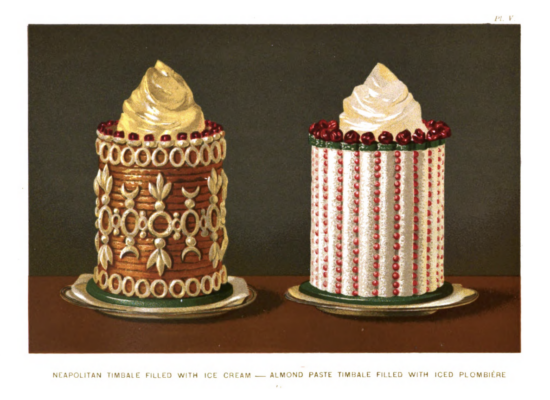
NEAPOLITAN TIMBALE
Make the paste in the way described for Timbale àla Chateaubriand (I have written that recipe out for you further down this page), using:
10 oz (283.5 grams). of Jordan almonds,
10 oz (283.5 grams). of pounded sugar,
10 oz (283.5 grams). of butter,
1 lb (0.45 kilograms). of flour,
the grated peel of a lemon,
a small pinch of salt,
as many yolks of egg as are required to make a stiffish
paste ; Roll the paste out to inch thickness, cut it into rounds with
a 4-inch plain cutter, and cut out the inside of each round with a
3-inch plain cutter ;
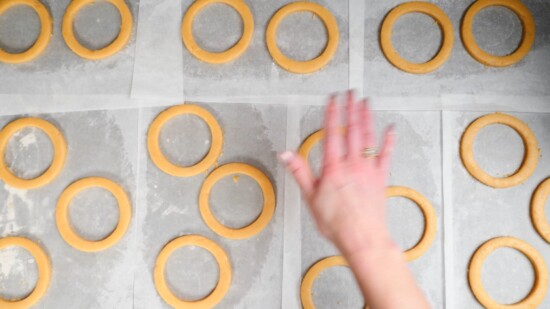
Bake the rings of paste in a slack oven until they acquire a
light golden tinge ;
Make a stiff icing with some red currant juice and fine sugar,
and put it into a paper cone ;
When the paste rings are cold, press out some of the icing on
one of them, stick another on the top, and continue in the same
way until all the rings are stuck one above the other, with the
icing shewing between each ;
Make and bake a round of pâte d’office 6 inches (15.24 centimetres) in diameter,
brush it over with a little white of egg, and strew it with green
sugar ;
When the timbale is dry, trim the outside very smooth, glaze
it with some apricot jam, previously rubbed through a silk sieve ;
put it on the round of pâte d’office, and ornament it with some
puff paste patterns made in the following manner :
Make some Puff Paste (vide page 40), using very white butter,
give it 12 turns, roll it out to 1 inch (2.54 centimetres) thickness, and cut it with
some fancy cutters, dredge some fine sugar over the patterns, and
bake them in a brisk oven ; the patterns should still be flexible
when they are taken out of the oven ;
Stick them on the timbale, being careful not to break them;

When about to serve, fill the timbale with some Vanilla Cream
Ice (vide Chapter XI. ), heaping it up above the top of the timbale
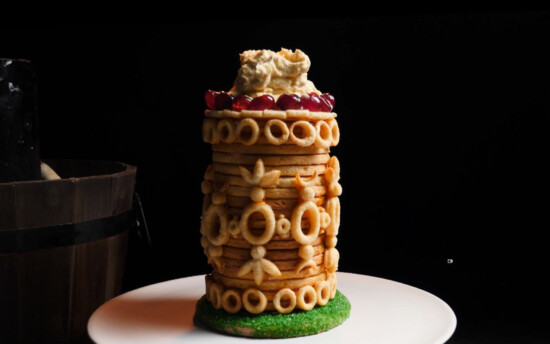
Split 2 sticks of vanilla lengthwise in four pieces, Take : Take : fold over one third of the length, flatten it slightly with the
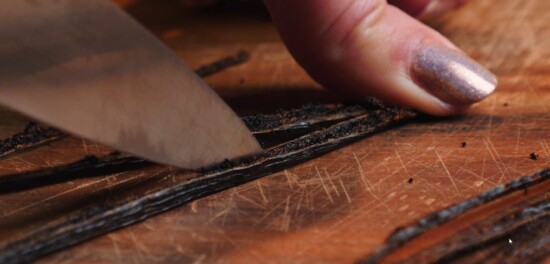
and put the pieces into the boiling cream, cover the stewpan, and let the
vanilla steep for an hour ;
Break 12 yolks of egg in a stewpan, add 12 oz (340.19 grams) . of pounded
sugar, and work them together with a wooden spoon ; mix in the
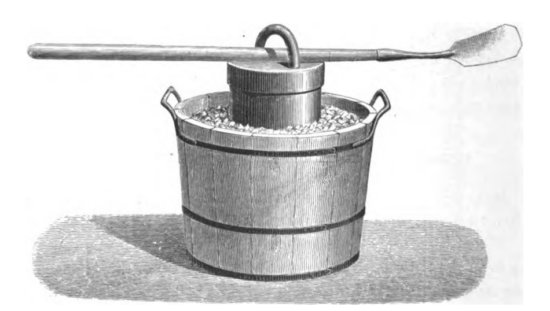
vanilla cream, and stir over the fire, without boiling, until the
custard coats the spoon ;
Strain the cream through a silk sieve into a basin, and let it
get cold, stirring it occasionally to prevent a skin forming on the
surface ;
Should the cream be lumpy, it must be strained again ;
Set a freezing-pot in some mixed pounded ice and bay-salt,
pour in the cream, work it with the spatula, and, when it is set,
mix in 3 gills of whipped double cream, close the freezing- pot,
and cover it with pounded ice ;
At the end of two hours, uncover the freezing-pot and dish the
vanilla ice on a napkin in an irregular pile.
The ice can be moulded in fancy moulds, as follows :
Set the moulds in the ice ;
When the cream has been frozen and worked in the freezing
pot as above, fill the moulds with it, close them , spread some
butter over the openings, and imbed the moulds in pounded ice
and bay- salt ; place a folded wet cloth on the top ; let the
moulds remain thus till the ices are wanted, and turn them out
of the moulds on to a napkin on a dish.
Chocolate, Orange, Lemon, Orange Flower Water, and Tea
Ices are prepared in the same way by mixing the flavouring with
the cream.TIMBALE À LA CHATEAUBRIAND
lb. of Jordan almonds, 8 yolks of egg,
lb. of pounded sugar,
6 oz (170.1 grams). of flour,
2 oz (56.7 grams). of butter,
the grated peel of a lemon,
a small pinch of salt ;
Blanch, peel, wash, and dry the almonds, and pound them in
a mortar, moistening with some white of egg to prevent their
turning oily ;
when well pounded, add the butter, the sugar, the
flour, the lemon, and the salt, and mix to a stiffish paste with the
yolks of egg added one at a time ;
Let the paste rest for an hour, and roll it out to 1/8 thickness ;
cut out two strips as wide as the height of the mould used for
making the timbale ; bake the two strips of paste in a slack oven
until they acquire a light golden tinge ; then trim the strips very
smooth, and cut them across in pieces 1 inch (2.54 centimetres) wide ;
Roll the remainder of the paste to inch thickness, bake it
also so that it may acquire a light golden tinge, and cut it ,
whilst hot, with a plain 1 inch (2.54 centimetres) round cutter ;PUFF PASTE
1 lb (0.45 kilograms). of flour,
1 lb (0.45 kilograms). of butter,
oz. of salt,
3 gills of water ;
Sift the flour on to the pasteboard, make a hole in the middle,
put in the salt and part of the water, mix, adding the water by
degrees, being careful to sprinkle the water all over the flour
and to mix it evenly ;
PART] PASTES 41
Work the paste well, and, when it no longer adheres to the
board, roll it out to a round about 3 inches (7.62 centimetres) thick, and let it rest
for five minutes ;
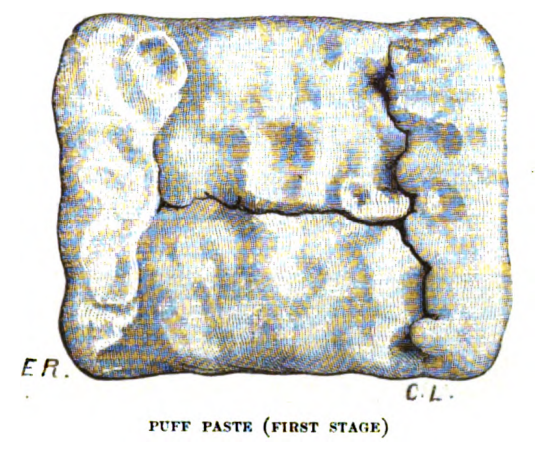
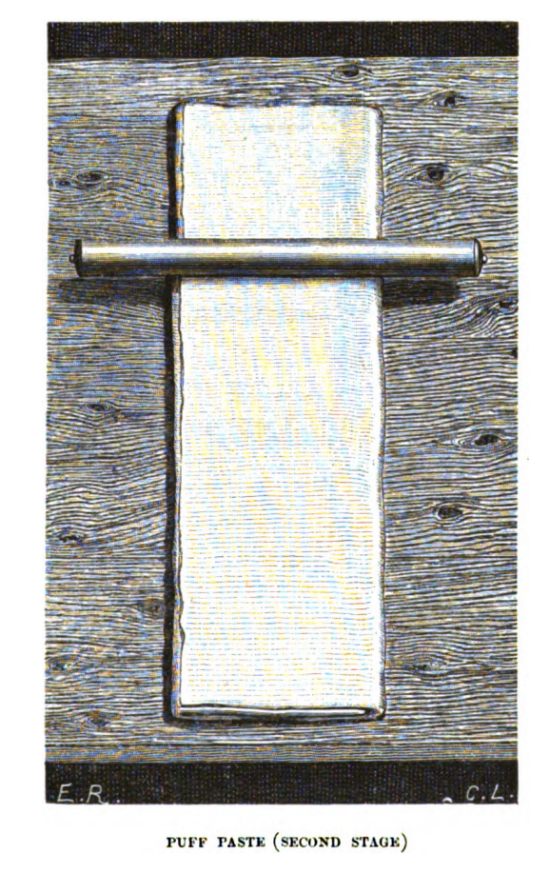
Work the butter in a cloth to expel all the water which is in
it , and, if the paste is made in winter, work the butter until it is
quite smooth ;
Spread the butter on to the paste, flatten both together to a
2-inch thickness, and fold over the sides of the paste so as to
enclose the butter and form a square (vide woodcut, page 41) ;
Roll out the paste to a 3-foot length ( vide woodcut, page 41 ) ,
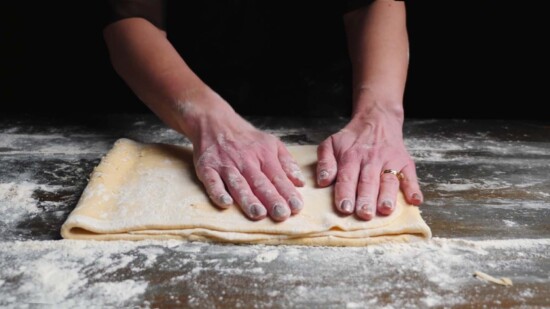
rolling pin, and fold the other third over this (vide woodcut).

Turn the paste round, roll it out again to a length of about 3
feet, fold it over, and repeat this six times, letting the paste rest
for ten minutes between every two turns.
My Cookbook
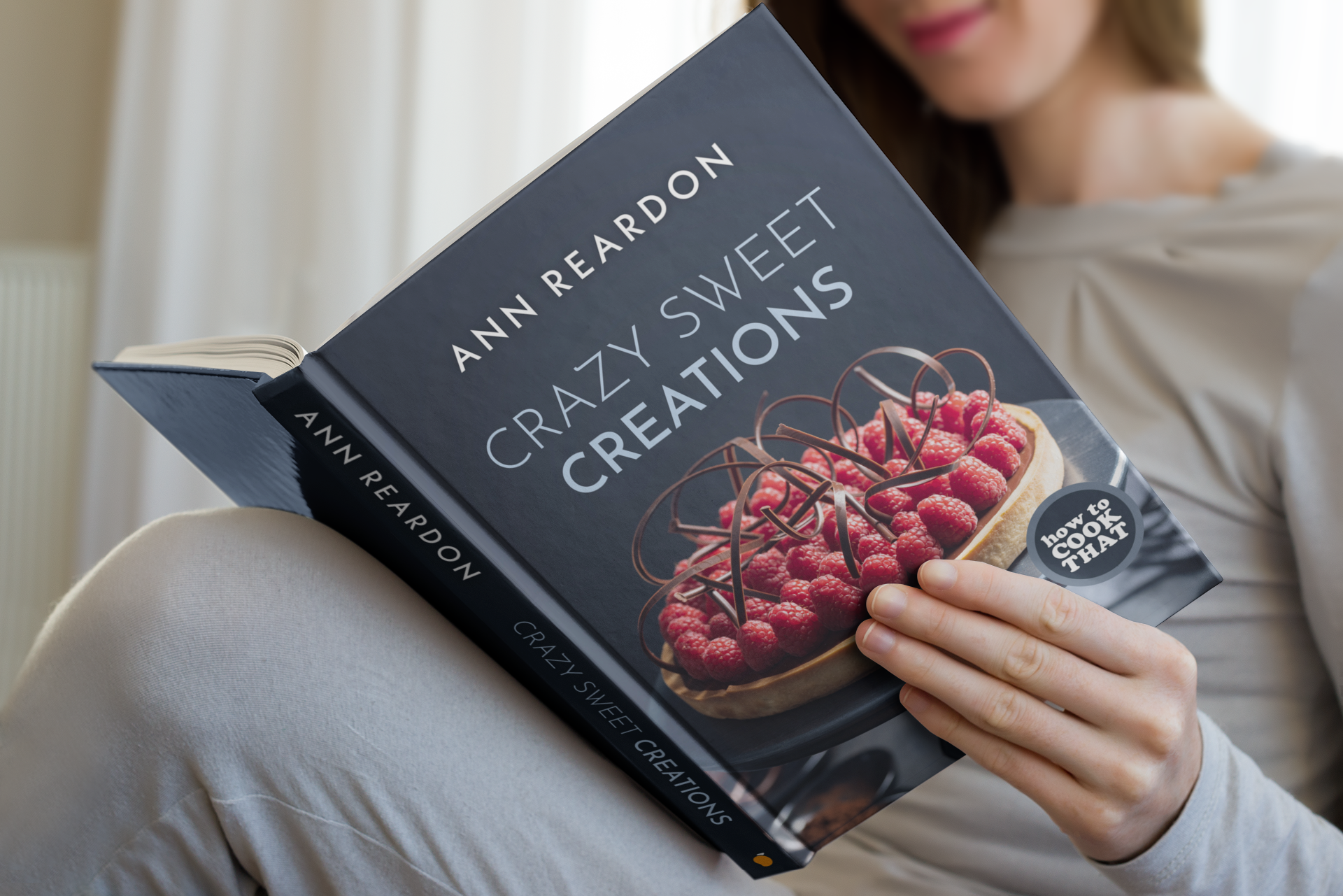 Stores that sell my book listed by country:
http://bit.ly/ARcookbook
All recipe quantities in the book are in grams, ounces and cups.
Stores that sell my book listed by country:
http://bit.ly/ARcookbook
All recipe quantities in the book are in grams, ounces and cups.



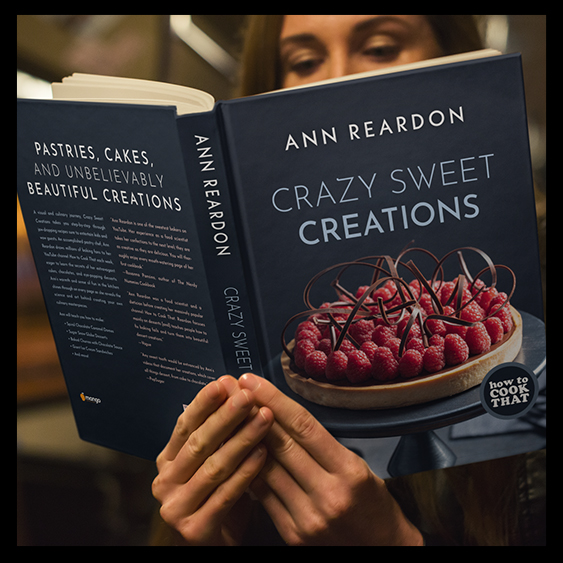






 we respect your email privacy
we respect your email privacy
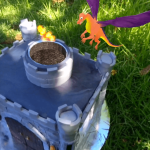



I would be hopeless at making that but they actually look pretty good and in the olden days they did used to cook calf heads in the 1850’s for like mock turtle soup
That was pretty amazing! I do not think that I would have the patience to make it the old fashioned way though.